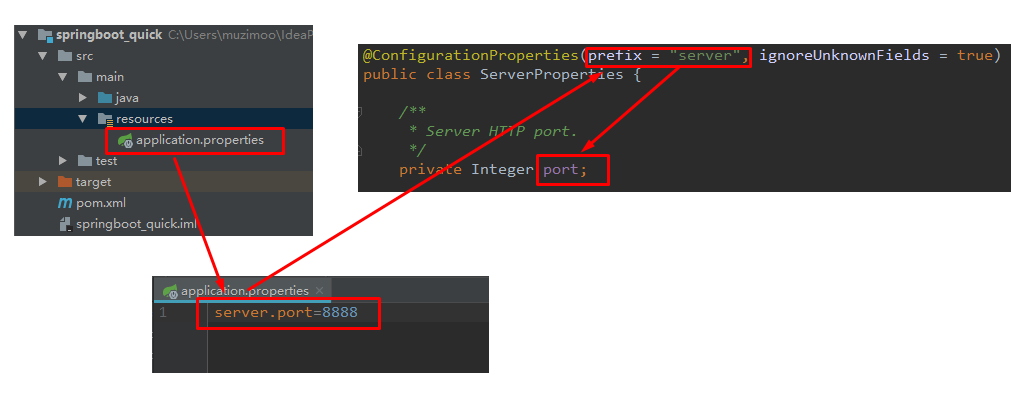SpringBoot原理分析與配置
1.1 起步依賴原理分析
1.1.1 分析spring-boot-starter-parent
按住Ctrl點選pom.xml中的spring-boot-starter-parent,跳轉到了spring-boot-starter-parent的pom.xml,xml配置如下(只摘抄了部分重點配置):
<parent> <groupId>org.springframework.boot</groupId> <artifactId>spring-boot-dependencies</artifactId> <version>2.0.1.RELEASE</version> <relativePath>../../spring-boot-dependencies</relativePath> </parent>
按住Ctrl點選pom.xml中的spring-boot-starter-dependencies,跳轉到了spring-boot-starter-dependencies的pom.xml,xml配置如下(只摘抄了部分重點配置):
<properties> <activemq.version>5.15.3</activemq.version> <antlr2.version>2.7.7</antlr2.version> <appengine-sdk.version>1.9.63</appengine-sdk.version> <artemis.version>2.4.0</artemis.version> <aspectj.version>1.8.13</aspectj.version> <assertj.version>3.9.1</assertj.version> <atomikos.version>4.0.6</atomikos.version> <bitronix.version>2.1.4</bitronix.version> <build-helper-maven-plugin.version>3.0.0</build-helper-maven-plugin.version> <byte-buddy.version>1.7.11</byte-buddy.version> ... ... ... </properties> <dependencyManagement> <dependencies> <dependency> <groupId>org.springframework.boot</groupId> <artifactId>spring-boot</artifactId> <version>2.0.1.RELEASE</version> </dependency> <dependency> <groupId>org.springframework.boot</groupId> <artifactId>spring-boot-test</artifactId> <version>2.0.1.RELEASE</version> </dependency> ... ... ... </dependencies> </dependencyManagement> <build> <pluginManagement> <plugins> <plugin> <groupId>org.jetbrains.kotlin</groupId> <artifactId>kotlin-maven-plugin</artifactId> <version>${kotlin.version}</version> </plugin> <plugin> <groupId>org.jooq</groupId> <artifactId>jooq-codegen-maven</artifactId> <version>${jooq.version}</version> </plugin> <plugin> <groupId>org.springframework.boot</groupId> <artifactId>spring-boot-maven-plugin</artifactId> <version>2.0.1.RELEASE</version> </plugin> ... ... ... </plugins> </pluginManagement> </build>
從上面的spring-boot-starter-dependencies的pom.xml中我們可以發現,一部分座標的版本、依賴管理、外掛管理已經定義好,所以我們的SpringBoot工程繼承spring-boot-starter-parent後已經具備版本鎖定等配置了。所以起步依賴的作用就是進行依賴的傳遞。
1.1.2 分析spring-boot-starter-web
按住Ctrl點選pom.xml中的spring-boot-starter-web,跳轉到了spring-boot-starter-web的pom.xml,xml配置如下(只摘抄了部分重點配置):
<?xml version="1.0" encoding="UTF-8"?> <project xsi:schemaLocation="http://maven.apache.org/POM/4.0.0 http://maven.apache.org/xsd/maven-4.0.0.xsd" xmlns="http://maven.apache.org/POM/4.0.0" xmlns:xsi="http://www.w3.org/2001/XMLSchema-instance"> <modelVersion>4.0.0</modelVersion> <parent> <groupId>org.springframework.boot</groupId> <artifactId>spring-boot-starters</artifactId> <version>2.0.1.RELEASE</version> </parent> <groupId>org.springframework.boot</groupId> <artifactId>spring-boot-starter-web</artifactId> <version>2.0.1.RELEASE</version> <name>Spring Boot Web Starter</name> <dependencies> <dependency> <groupId>org.springframework.boot</groupId> <artifactId>spring-boot-starter</artifactId> <version>2.0.1.RELEASE</version> <scope>compile</scope> </dependency> <dependency> <groupId>org.springframework.boot</groupId> <artifactId>spring-boot-starter-json</artifactId> <version>2.0.1.RELEASE</version> <scope>compile</scope> </dependency> <dependency> <groupId>org.springframework.boot</groupId> <artifactId>spring-boot-starter-tomcat</artifactId> <version>2.0.1.RELEASE</version> <scope>compile</scope> </dependency> <dependency> <groupId>org.hibernate.validator</groupId> <artifactId>hibernate-validator</artifactId> <version>6.0.9.Final</version> <scope>compile</scope> </dependency> <dependency> <groupId>org.springframework</groupId> <artifactId>spring-web</artifactId> <version>5.0.5.RELEASE</version> <scope>compile</scope> </dependency> <dependency> <groupId>org.springframework</groupId> <artifactId>spring-webmvc</artifactId> <version>5.0.5.RELEASE</version> <scope>compile</scope> </dependency> </dependencies> </project>
從上面的spring-boot-starter-web的pom.xml中我們可以發現,spring-boot-starter-web就是將web開發要使用的spring-web、spring-webmvc等座標進行了“打包”,這樣我們的工程只要引入spring-boot-starter-web起步依賴的座標就可以進行web開發了,同樣體現了依賴傳遞的作用。
1.2 自動配置原理解析
按住Ctrl點選檢視啟動類MySpringBootApplication上的註解@SpringBootApplication
@SpringBootApplication
public class MySpringBootApplication {
public static void main(String[] args) {
SpringApplication.run(MySpringBootApplication.class);
}
}註解@SpringBootApplication的原始碼
@Target(ElementType.TYPE)
@Retention(RetentionPolicy.RUNTIME)
@Documented
@Inherited
@SpringBootConfiguration
@EnableAutoConfiguration
@ComponentScan(excludeFilters = {
@Filter(type = FilterType.CUSTOM, classes = TypeExcludeFilter.class),
@Filter(type = FilterType.CUSTOM, classes = AutoConfigurationExcludeFilter.class) })
public @interface SpringBootApplication {
/**
* Exclude specific auto-configuration classes such that they will never be applied.
* @return the classes to exclude
*/
@AliasFor(annotation = EnableAutoConfiguration.class)
Class<?>[] exclude() default {};
... ... ...
}其中,
@SpringBootConfiguration:等同與@Configuration,既標註該類是Spring的一個配置類
@EnableAutoConfiguration:SpringBoot自動配置功能開啟
按住Ctrl點選檢視註解@EnableAutoConfiguration
@Target(ElementType.TYPE)
@Retention(RetentionPolicy.RUNTIME)
@Documented
@Inherited
@AutoConfigurationPackage
@Import(AutoConfigurationImportSelector.class)
public @interface EnableAutoConfiguration {
... ... ...
}其中,@Import(AutoConfigurationImportSelector.class) 匯入了AutoConfigurationImportSelector類
按住Ctrl點選檢視AutoConfigurationImportSelector原始碼
public String[] selectImports(AnnotationMetadata annotationMetadata) {
... ... ...
List<String> configurations = getCandidateConfigurations(annotationMetadata,
attributes);
configurations = removeDuplicates(configurations);
Set<String> exclusions = getExclusions(annotationMetadata, attributes);
checkExcludedClasses(configurations, exclusions);
configurations.removeAll(exclusions);
configurations = filter(configurations, autoConfigurationMetadata);
fireAutoConfigurationImportEvents(configurations, exclusions);
return StringUtils.toStringArray(configurations);
}
protected List<String> getCandidateConfigurations(AnnotationMetadata metadata,
AnnotationAttributes attributes) {
List<String> configurations = SpringFactoriesLoader.loadFactoryNames(
getSpringFactoriesLoaderFactoryClass(), getBeanClassLoader());
return configurations;
}
其中,SpringFactoriesLoader.loadFactoryNames 方法的作用就是從META-INF/spring.factories檔案中讀取指定類對應的類名稱列表

spring.factories 檔案中有關自動配置的配置資訊如下:
... ... ...
org.springframework.boot.autoconfigure.web.reactive.function.client.WebClientAutoConfiguration,\
org.springframework.boot.autoconfigure.web.servlet.DispatcherServletAutoConfiguration,\
org.springframework.boot.autoconfigure.web.servlet.ServletWebServerFactoryAutoConfiguration,\
org.springframework.boot.autoconfigure.web.servlet.error.ErrorMvcAutoConfiguration,\
org.springframework.boot.autoconfigure.web.servlet.HttpEncodingAutoConfiguration,\
org.springframework.boot.autoconfigure.web.servlet.MultipartAutoConfiguration,\
... ... ...上面配置檔案存在大量的以Configuration為結尾的類名稱,這些類就是存有自動配置資訊的類,而SpringApplication在獲取這些類名後再載入
我們以ServletWebServerFactoryAutoConfiguration為例來分析原始碼:
@Configuration
@AutoConfigureOrder(Ordered.HIGHEST_PRECEDENCE)
@ConditionalOnClass(ServletRequest.class)
@ConditionalOnWebApplication(type = Type.SERVLET)
@EnableConfigurationProperties(ServerProperties.class)
@Import({ ServletWebServerFactoryAutoConfiguration.BeanPostProcessorsRegistrar.class,
ServletWebServerFactoryConfiguration.EmbeddedTomcat.class,
ServletWebServerFactoryConfiguration.EmbeddedJetty.class,
ServletWebServerFactoryConfiguration.EmbeddedUndertow.class })
public class ServletWebServerFactoryAutoConfiguration {
... ... ...
}
其中,
@EnableConfigurationProperties(ServerProperties.class) 代表載入ServerProperties伺服器配置屬性類
進入ServerProperties.class原始碼如下:
@ConfigurationProperties(prefix = "server", ignoreUnknownFields = true)
public class ServerProperties {
/**
* Server HTTP port.
*/
private Integer port;
/**
* Network address to which the server should bind.
*/
private InetAddress address;
... ... ...
}其中,
prefix = "server" 表示SpringBoot配置檔案中的字首,SpringBoot會將配置檔案中以server開始的屬性對映到該類的欄位中。對映關係如下:

二、SpringBoot的配置檔案
2.1 SpringBoot配置檔案型別
2.1.1 SpringBoot配置檔案型別和作用
SpringBoot是基於約定的,所以很多配置都有預設值,但如果想使用自己的配置替換預設配置的話,就可以使用application.properties或者application.yml(application.yaml)進行配置。
SpringBoot預設會從Resources目錄下載入application.properties或application.yml(application.yaml)檔案
其中,application.properties檔案是鍵值對型別的檔案,之前一直在使用,所以此處不在對properties檔案的格式進行闡述。除了properties檔案外,SpringBoot還可以使用yml檔案進行配置,下面對yml檔案進行講解。
2.1.2 application.yml配置檔案
2.1.2.1 yml配置檔案簡介
YML檔案格式是YAML (YAML Aint Markup Language)編寫的檔案格式,YAML是一種直觀的能夠被電腦識別的的資料資料序列化格式,並且容易被人類閱讀,容易和指令碼語言互動的,可以被支援YAML庫的不同的程式語言程式匯入,比如: C/C++, Ruby, Python, Java, Perl, C#, PHP等。YML檔案是以資料為核心的,比傳統的xml方式更加簡潔。
YML檔案的副檔名可以使用.yml或者.yaml。
2.1.2.2 yml配置檔案的語法
2.1.2.2.1 配置普通資料
語法: key: value
示例程式碼:
name: haohao注意:value之前有一個空格
2.1.2.2.2 配置物件資料
語法:
key:
key1: value1
key2: value2
或者:
key: {key1: value1,key2: value2}
示例程式碼:
person: name: haohao age: 31 addr: beijing #或者 person: {name: haohao,age: 31,addr: beijing}注意:key1前面的空格個數不限定,在yml語法中,相同縮排代表同一個級別
2.1.2.2.2 配置Map資料
同上面的物件寫法
2.1.2.2.3 配置陣列(List、Set)資料
語法:
key:
- value1
- value2
或者:
key: [value1,value2]
示例程式碼:
city: - beijing - tianjin - shanghai - chongqing #或者 city: [beijing,tianjin,shanghai,chongqing] #集合中的元素是物件形式 student: - name: zhangsan age: 18 score: 100 - name: lisi age: 28 score: 88 - name: wangwu age: 38 score: 90注意:value1與之間的 - 之間存在一個空格
2.1.3 SpringBoot配置資訊的查詢
上面提及過,SpringBoot的配置檔案,主要的目的就是對配置資訊進行修改的,但在配置時的key從哪裡去查詢呢?我們可以查閱SpringBoot的官方文件
文件URL:https://docs.spring.io/spring-boot/docs/2.0.1.RELEASE/reference/htmlsingle/#common-application-properties
常用的配置摘抄如下:
# QUARTZ SCHEDULER (QuartzProperties)
spring.quartz.jdbc.initialize-schema=embedded # Database schema initialization mode.
spring.quartz.jdbc.schema=classpath:org/quartz/impl/jdbcjobstore/tables_@@platform@@.sql # Path to the SQL file to use to initialize the database schema.
spring.quartz.job-store-type=memory # Quartz job store type.
spring.quartz.properties.*= # Additional Quartz Scheduler properties.
# ----------------------------------------
# WEB PROPERTIES
# ----------------------------------------
# EMBEDDED SERVER CONFIGURATION (ServerProperties)
server.port=8080 # Server HTTP port.
server.servlet.context-path= # Context path of the application.
server.servlet.path=/ # Path of the main dispatcher servlet.
# HTTP encoding (HttpEncodingProperties)
spring.http.encoding.charset=UTF-8 # Charset of HTTP requests and responses. Added to the "Content-Type" header if not set explicitly.
# JACKSON (JacksonProperties)
spring.jackson.date-format= # Date format string or a fully-qualified date format class name. For instance, `yyyy-MM-dd HH:mm:ss`.
# SPRING MVC (WebMvcProperties)
spring.mvc.servlet.load-on-startup=-1 # Load on startup priority of the dispatcher servlet.
spring.mvc.static-path-pattern=/** # Path pattern used for static resources.
spring.mvc.view.prefix= # Spring MVC view prefix.
spring.mvc.view.suffix= # Spring MVC view suffix.
# DATASOURCE (DataSourceAutoConfiguration & DataSourceProperties)
spring.datasource.driver-class-name= # Fully qualified name of the JDBC driver. Auto-detected based on the URL by default.
spring.datasource.password= # Login password of the database.
spring.datasource.url= # JDBC URL of the database.
spring.datasource.username= # Login username of the database.
# JEST (Elasticsearch HTTP client) (JestProperties)
spring.elasticsearch.jest.password= # Login password.
spring.elasticsearch.jest.proxy.host= # Proxy host the HTTP client should use.
spring.elasticsearch.jest.proxy.port= # Proxy port the HTTP client should use.
spring.elasticsearch.jest.read-timeout=3s # Read timeout.
spring.elasticsearch.jest.username= # Login username.
我們可以通過配置application.poperties 或者 application.yml 來修改SpringBoot的預設配置
例如:
application.properties檔案
server.port=8888
server.servlet.context-path=demoapplication.yml檔案
server:
port: 8888
servlet:
context-path: /demo2.2 配置檔案與配置類的屬性對映方式
2.2.1 使用註解@Value對映
我們可以通過@Value註解將配置檔案中的值對映到一個Spring管理的Bean的欄位上
例如:
application.properties配置如下:
person:
name: zhangsan
age: 18或者,application.yml配置如下:
person:
name: zhangsan
age: 18實體Bean程式碼如下:
@Controller
public class QuickStartController {
@Value("${person.name}")
private String name;
@Value("${person.age}")
private Integer age;
@RequestMapping("/quick")
@ResponseBody
public String quick(){
return "springboot 訪問成功! name="+name+",age="+age;
}
}瀏覽器訪問地址:http://localhost:8080/quick 結果如下:
2.2.2 使用註解@ConfigurationProperties對映
通過註解@ConfigurationProperties(prefix="配置檔案中的key的字首")可以將配置檔案中的配置自動與實體進行對映
application.properties配置如下:
person:
name: zhangsan
age: 18或者,application.yml配置如下:
person:
name: zhangsan
age: 18實體Bean程式碼如下:
@Controller
@ConfigurationProperties(prefix = "person")
public class QuickStartController {
private String name;
private Integer age;
@RequestMapping("/quick")
@ResponseBody
public String quick(){
return "springboot 訪問成功! name="+name+",age="+age;
}
public void setName(String name) {
this.name = name;
}
public void setAge(Integer age) {
this.age = age;
}
}瀏覽器訪問地址:http://localhost:8080/quick

注意:使用@ConfigurationProperties方式可以進行配置檔案與實體欄位的自動對映,但需要欄位必須提供set方法才可以,而使用@Value註解修飾的欄位不需要提供set方
